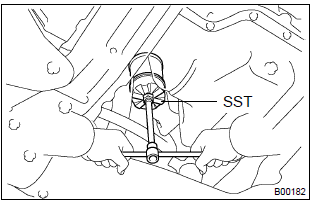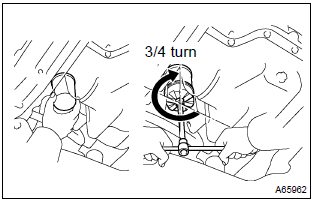Toyota Corolla (E120) 2002–2008 Repair Manual / Lubrication / Oil filter sub–assy
Toyota Corolla (E120): Oil filter sub–assy
Replacement
Caution
:
- prolonged and repeated contact with mineral oil will result in the removal of natural fats from the skin, leading to dryness, irritation and dermatitis. In addition, used engine oil contains potentially harmful contaminants which may cause skin cancer.
- Exercise caution in order to minimize the length and frequency of contact of your skin to used oil. Wear protective clothing and gloves. Wash your skin thoroughly with soap and water, or use water–less hand cleaner to remove any used engine oil. Do not use gasoline, thinners, or solvents.
- In order to preserve the environment, used oil and used oil filter must be disposed of only at designated disposal sites.
1. Remove engine under cover rh
2. Drain engine oil
- remove the oil pan drain plug and drain the engine oil.
3. Remove oil filter sub–assy

- Using sst, remove the oil filter sst 09228–06501
4. Install oil filter sub–assy

- Check and clean the oil filter installation surface.
- apply clean engine oil to the gasket of a new oil filter.
- lightly screw the oil filter into place, and tighten it until the gasket contacts the seat.
- using sst, tighten it an additional 3/4 turn.
Sst 09228–06501
5. Install oil pan drain plug
- Clean and install the oil pan drain plug with a new gasket.
Torque: 37 nvm (377 Kgf·cm, 27 in.Vlbf)
6. Add engine oil
Capacity:
drain and refill w/ oil filter change 3.7 Liters (3.9 Us qts, 3.3 Lmp. Qts)
drain and refill w/o oil filter change 3.5 Liters (3.7 Us qts, 3.1 Lmp. Qts)
dry fill 4.2 Liters (4.4 Us qts, 3.7 Lmp. Qts)
7. Inspect oil leak
Other materials:
Inspection procedure
1 Check side squib(lh) circuit(airbag sensor assy center – front
seat airbag assy lh)
Disconnect the negative (–) terminal cable from the battery,
and wait at least for 90 seconds.
disconnect the connectors between the airbag sensor
assy center and the front seat airbag assy ...
Disposal
Hint:
when scrapping vehicles epuipped with a seat belt pretensioner or disposing of a
front seat outer belt (with
seat belt pretensioner) always first active the seat belt pretensioner in
accordance with the procedure described
below. If any abnormality occurs in the seat belt pretensioner o ...
Pre–check
1. Srs warning light check
Turn the ignition switch to the on position and check that
the srs warning light lights up.
check that the srs warning light goes out after approx.
6 Seconds.
Hint:
when the ignition switch is at on and the srs warning
light remains on or flashes, the ...


